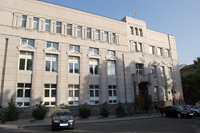The official statistics is reporting about not only growth in the economy and industry sector, but also in the banking sector. The double-digit growth of the last year concerns the banking system, namely the crediting sector.
According to the official information, the credit investments on the part of banks in the end of 2011 was 1,337 trillion drams (3,4 billion dollars). Compared to 2010 the credit investment capacity has grown by 34%. The average return of assets of actives was 36%, and the return of equity was 12,55%. In the entire credit portfolio system the trade occupies 21%, industry – 19%, consumption credits – 19%, construction and mortgage credits – 8% each, agriculture – 6%. Compared to 2010 the credit investments in the economy have grown by 44,3%. The credit investment capacity relation to the GDP was 34,9%, which is more than the same level in 2010 by 6,3%. The relation of assets with the GDP is 54,2%, and the investments on the part of private persons – 14,6%.
At first look everything seems to be fine and that banks are financing the economy. However, when we compare it with the statistics on credits, the picture is changing. According to the information of the national statistics service, in the end of December 2011 the remaining amount of credits in banks was 969.7 billion drams. In the end of 2010 this amount was 702.2 billion. This means that the capacity of credits has grown by 267.5 billion drams during one year. This is not a small amount but is much smaller than the loans. The growth of the capacity of loans is higher by 68.8 billion drams than the capacity of credits.
What does this mean? The main logic of the work of banks is that they are reallocating resources, i.e. they collect the free resources from people and giving those resources to those who need them. In the current situation the statistics shows that about 68.8 billion drams (180 million dollars) has been refinanced not on the account of domestic resources but resources received from external sources. This is not a small amount for a small market like Armenia.
This means that the banking system does not do its functions in a duly manner, but contains a number of risks as well. Policy Forum Armenia has published a report on possible crisis, in which the report discussed the banking system and crediting conditions in detail. “While everywhere the crediting capacities have been cut down, the Armenian banking system has significantly increased the crediting capacity since 2008, most of which was done through borrowing money from external sources, thus collecting a lot of debts on the part of banks. Due to the rapid growth of crediting, the quality of credits is highly suspected. Most of the growth was due to borrowings in foreign currency (which according to the IMF was the 60% in 2011), which made the system even more vulnerable in terms of the dram inflation possible. The level of dollarization of deposits remains high, which limits the effectiveness of monetary policy,” writes the report. The recent developments in the banking system show that the connection between debits and credits is very weak. For example, one of the banks recently announced that was going to increase the interest rate for deposits in drams to 13%. Shortly another bank announced about accepting deposits with 14% interest rate. Bankers say in private conversations that banks are in a strong competition to attract deposits as much as they can and for this purpose they are offering high interest rates. Maybe creditors are interested in high interest rates but this is against the logic of the banking system. On the one hand, the crediting interest rates are growing, and on the other hand banks are advertising low interest rates for loans. In this small banking system some of the banks are offering long money for 11-12% interest rates, and others take credits for 14% interest rate. If the trust to the national currency was higher, one could make money by taking money from one bank and giving to another. This tendency has another explanation too – banks are cutting down their margins. This means that they have agreed to reduce the difference between attracted resources and money they give out, thus making less money and profit. However, in Armenia it is difficult to believe in such possibility.
The only possible explanation is that the Armenian banks consider it possible the devaluation of AMD which will cover the negative outcomes of inflation. In spite of the above mentioned indices and the growth of loan volumes the RA banks are not much involved in the economy. As we have already mentioned, volumes of the loans provided by banks made 34.9% of GDP in 2011. It is truth that in comparison to the last year there is a slight growth. However, we have to take into consideration that in the US this index is 23% and in the European countries 120-130%. Nevertheless, we should not be sad for the RA banking system. They will apparently have a successful future and face the radical growth of circulation volumes. It concerns the law on limiting cash transaction which has recently failed at the National Assembly because of the political reasons. Thus, the adoption of this law is a matter of “dignity” for the ruling party and there is no doubt that it will soon be adopted. However at that time all of us will be obliged to address the banks in case we conduct transactions worth more than 3 million drams. We have already addressed the fact that in case the law is adopted the real estate market will increase the circulation of banking system by several tens of milliards of drams. Thus, not a single crisis will impact on the RA banking system if the government supports the Armenian banks.

